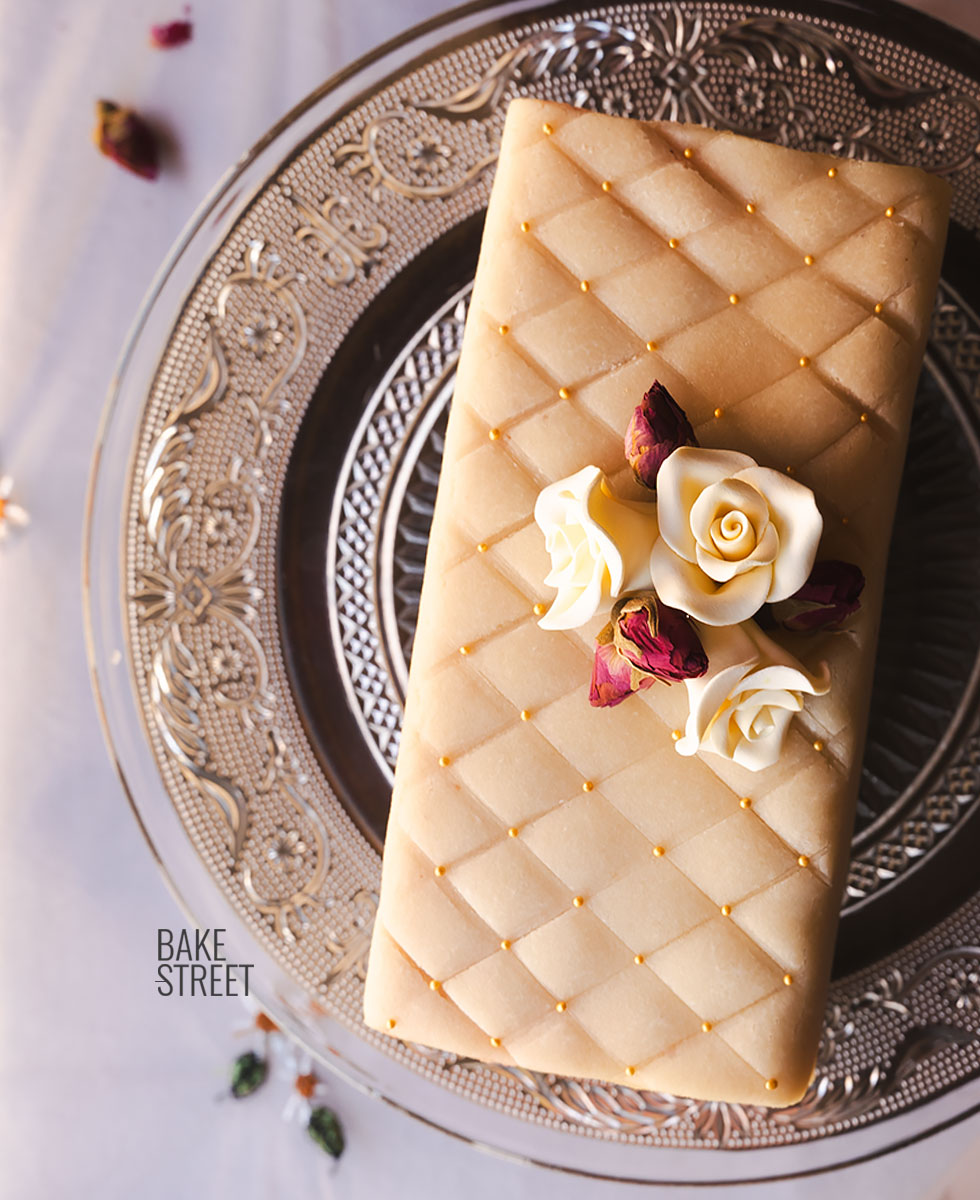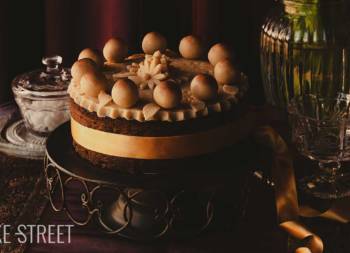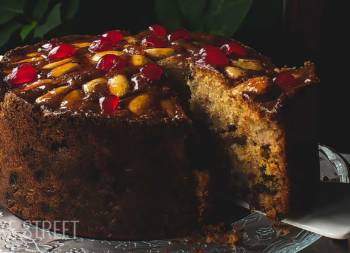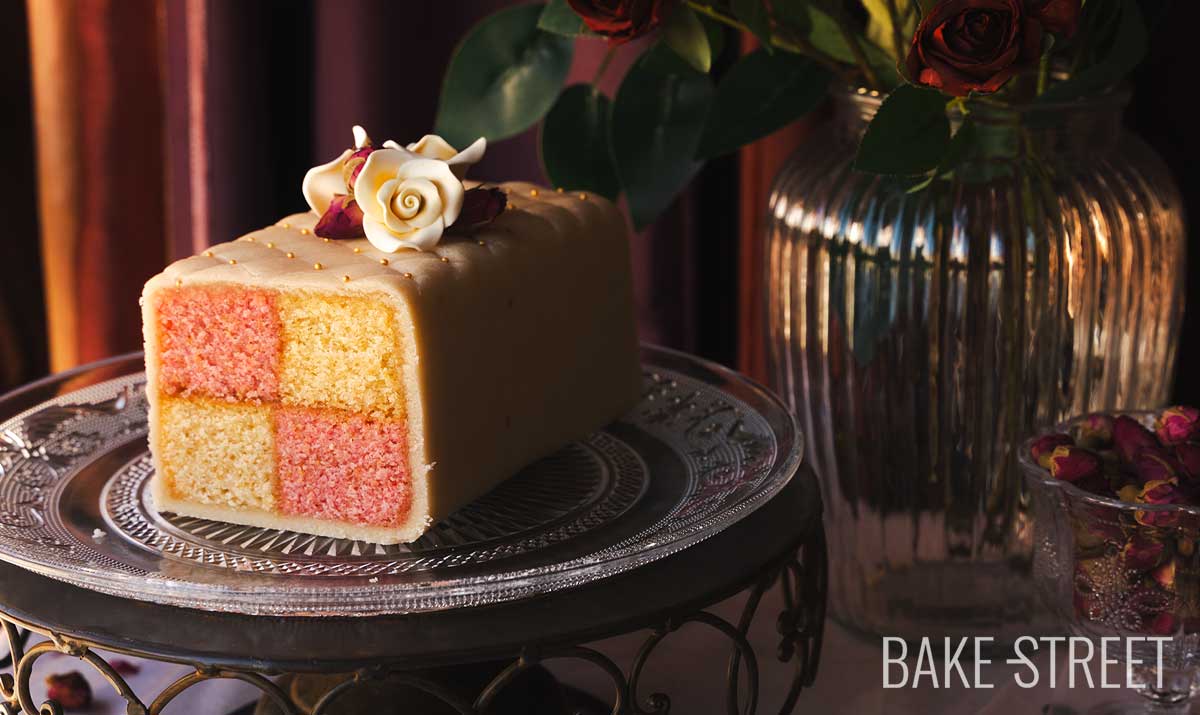
Battenberg Cake, British cake
I am going to leave you with a recipe that, surely, many of you already know, but for those who do not…. You can’t help but be encouraged to make it at home. It is the wonderful Battenberg Cake, a cake of British origin that is not only wonderful to look at, but also to taste.
An incredibly tender, soft, delicate sponge cake, with a checkerboard appearance in which two colors are combined that, personally, are fabulous; white and pink. Apricot jam is used to bind the sponge cakes together and these are wrapped with a thin layer of marzipan. Speechless, I promise.
I have already left you several sponge cakes or cakes with marzipan, such as the Simnel Cake or this Lübeck-style cherry, hazelnut and marzipan cake, and I admit that they fascinate me. I never cease to be amazed at how well these two elements work together.
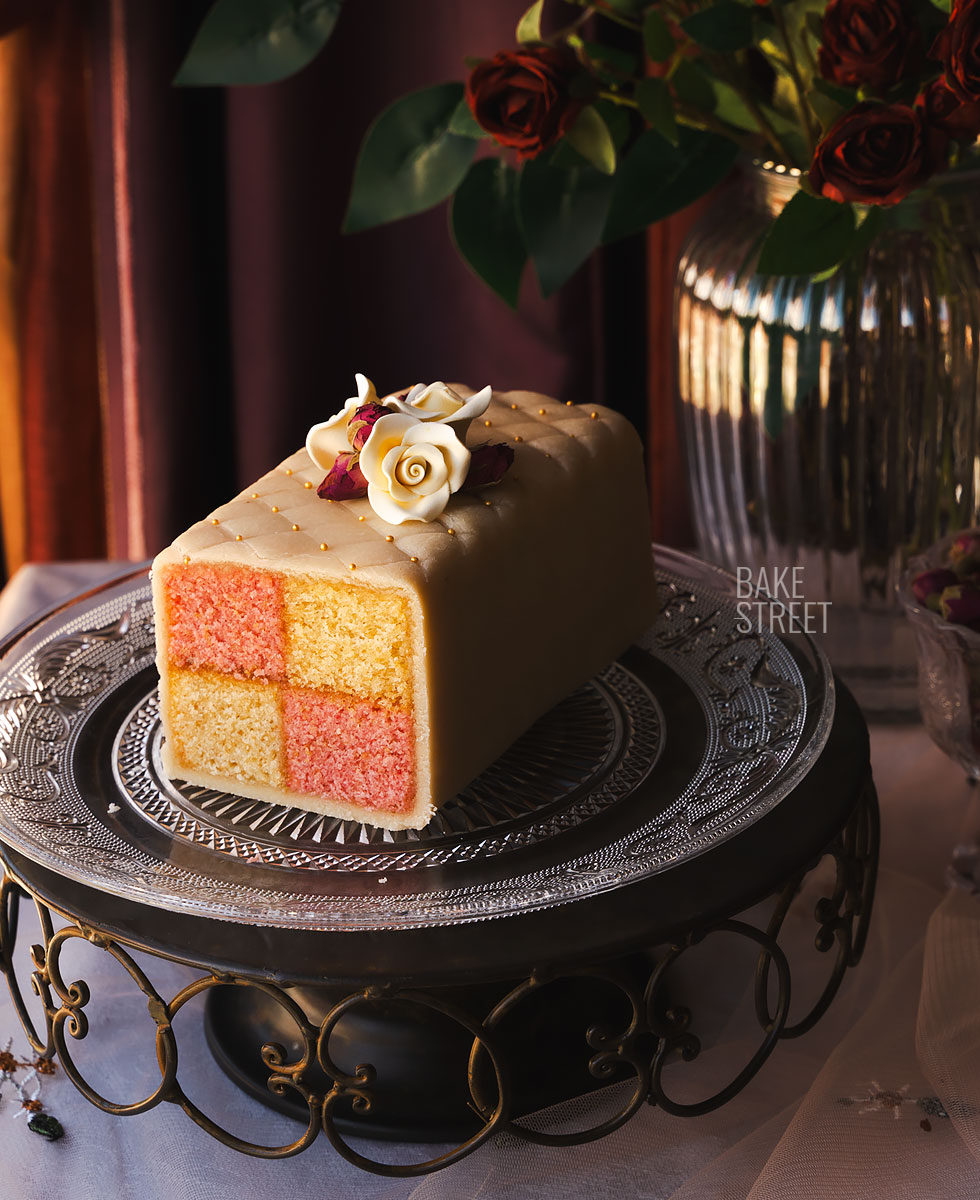
History and origin Battenberg Cake.
Battenberg Cake is a British cake that has given rise to various theories about its creation.
One of the most curious stories is that this cake was created to celebrate the wedding of Louis Mountbatten’s parents, Prince Louis of Battenberg and Princess Victoria of Darmstadt, in 1884. However, there is no solid evidence to support this theory.
Another version suggests that the four squares on the cake represent the four Battenberg brothers; Prince Louis, Prince Alexander (briefly King of Bulgaria before he abdicated), Prince Henry who married Princess Beatrice (Queen Victoria’s youngest daughter) and Prince Franz Joseph. However, this idea falls apart when we realize that the original cake consisted of nine squares.
Nor does there seem to be a connection with the Prussian village of Battenberg, from which the family took its name.
Another theory, which I honestly found most surprising, is that the Battenberg Cake may have been invented by Hitler’s mother or grandmother. This theory is completely false and easily dismissed, although quite curious. It was believed that the design of the cake could accommodate a swastika.
The most widely accepted theory was from a 19th century pastry chef.
The most widely accepted explanation takes us back to the 19th century, where a pastry chef named Frederick Vine probably invented this treat in 1898, long after the events that gave it its name.
Vine published the recipe in his book “Saleable Shop Goods” where his cake had nine alternating red and white sections covered with a layer of almond paste. Prior to this, in the 1890s, similar cakes with multiple squares were already being made under different names. Including the Neapolitan Roll published by Robert Wells, which had only four panels like the modern cake, and the Gateau à la Domino, which was probably invented by Mrs. Agnes Marshall, the editor of The Table magazine.
So why was it given the name Battenberg? Possibly as a marketing strategy to associate it with royalty, although it was often spelled incorrectly as Battenburg.
It may have existed for many years previously, known as “Church Window Cake”. The simpler four-panel version we know today probably began to facilitate mass production in the 1920s by the Lyons Company and others.

The Battenberg Cake has evolved over time.
And the modern version dispenses, in some cases, with the nuts. However, stores like Fortnum and Mason’s have been serving it as part of their afternoon tea since the 1920s.
There was another Battenberg wedding in the 1880s, that of Prince Henry to Princess Beatrice, daughter of Queen Victoria. However, their wedding cake was quite different from the Battenberg Cake we know today, in fact it is said to have been a very elaborate cake.
As a fun fact, the checkered pattern on emergency vehicles is officially called the Battenberg pattern. It is used in many countries, including Australia and Iceland. So the influence of the Battenberg Cake goes beyond baking.
Recipe Battenberg Cake
SPONGE CAKES:
- 300 g unsalted butter, room temperature
- 300 g sugar
- 300 g cake flour, sifted
- 5 eggs, large
- 65 g ground almonds
- 5 g baking powder
- 1 teaspoon vanilla extract
- 1 teaspoon of almond extract
- pink coloring paste, in my case I used the color “Claret”
MARZIPAN:
- 250 g ground almonds
- 235 g powdered sugar
- 13 g honey
- 40 g water
FILLING AND DECORATION:
- 150 g apricot jam, without chunks
- sugar flowers
- edible dried roses
- golden round sprinkles, small
MATERIAL THAT WE WILL NEED AND VISIBLE IN THE VIDEO:
- baking paper + aluminum foil
- stand mixer/kneader
- square pan 23 x 23 cm
- bowls
- rolling pin
- cooling rack
- pastry brush
Instructions
FIRST DAY
Prepare sponge cakes.
- Line a 23 x 23 cm square pan as shown in the video. Create a divider in the middle using aluminum foil. If you prefer, you can use two rectangular molds, which have similar dimensions, or a Battenberg cake pan.
- Preheat the oven to 355ºF/180ºC, heat up and down.
- To make the cake batter, cream the butter with the sugar. Add both ingredients in the bowl and beat with the whisk at medium high speed for 8-10 minutes.
- You should obtain a creamy, whitish and airy texture.
- Begin to add the eggs, one at a time and wait until they are fully integrated before adding the next one. I recommend beating the egg before pouring it over the creamed butter.
- Mix on medium speed until it is fully integrated, the aspect should be a smooth and homogeneous mixture, not curdle.
- Replace the whisk with the flat beater and add the ground almonds. Mix until it is evenly distributed, but do not exceed the mixing time.
- Finally, stir in the flour mixed with baking powder. Do it little by little and while mixing at low speed.
Divide the mixture into two equal parts.
- Divide the batter into two parts; in one of them add the vanilla and mix until homogenized. In the other, the one that will be colored, add the almond extract.
- To color the batter, separate a small amount in a bowl from the half containing the almond extract. Add the coloring paste and mix very well until homogenized.
- Incorporate this part to its corresponding half of the batter and mix until a uniformly colored batter is obtained.
- Distribute each of the batters in the holes of the mold, which we had reserved, and smooth the surface as much as possible.
Bake.
- Bake on the second rack, starting from the bottom, for 45-50 minutes or until a toothpick inserted in the center comes out clean.
- Let the cakes cool inside the mold and place on a cooling rack.
- Unmold, being very careful because the sponge cakes are very tender.
- Wrap each one in plastic wrap and refrigerate until the next day.
- NOTE: I recommend you to follow this step to facilitate the process of cutting the cake. Being cold, it acquires firmness and makes this step much easier.

SECOND DAY
Cut the sponge cakes.
- From each cake, 2 large rectangles will come out.
- Cut the domed part of the cake and remove the golden colored sides. Try to cut the cake as straight as possible.
- Repeat this same step with the other cake, if you wish, you can use the first cake as a guide to make sure they are the same size and height.
- Place one cake on top of the other and divide in half lengthwise.
- Assemble the cakes alternating the colors, so that you get a chess-like appearance.
- Wrap tightly with cling film while stretching the marzipan.
Roll the marzipan.
- To make the marzipan follow the process I share in this post. You can make the marzipan the day before, if you wish, and let it rest at room temperature tightly wrapped in plastic wrap. Or, if you prefer, you can make it the same day and let it rest for 2-4 hours before proceeding to use it.
- Sprinkle a work surface with powdered sugar and roll out the marzipan with a rolling pin. Try to stretch it to achieve sufficient dimensions to wrap the cake.
- As you stretch the marzipan, I recommend checking its size by placing the film-wrapped cake on top to make sure it is the correct size.
- Place it on a Teflon-lined tray and cover it with film to prevent it from drying out while you fill the cake.
Fill with jam.
- Temper the apricot jam, so it will be more fluid and it will be easier to brush the sponge cakes with it.
- Brush all the sides of the cake with jam, generously, and assemble the cake by placing the colors of the cake in a chessboard pattern.
- Brush a rectangle of jam on the marzipan and place the cake on it.
- Cover the entire outside surface of the cake brushing with the marmalade.
- Cover the sponge cake with the marzipan, the Teflon will help you to make this step easier. Make sure that the marzipan fits tightly to the cake, with no loose parts.
- Ideally, the sealed part of the marzipan should be at the base of the cake.
- Trim the excess marzipan and wrap in cling film. You can use it for other elaborations.
- Cut a piece from each end for a neat and attractive finish.
Decorate the outside, if desired.
- Using the edge of a knife, mark the surface of the cake (the marzipan) to create a lattice.
- Lightly moisten the joints of each line crossing and place a round golden sprinkle.
- Finally, decorate with sugar flowers and dehydrated edible roses.

Notes
- In my case I don't have a Battenberg mold and, in my video, I show you how to make the sponge cake for this cake without having one.
- To make the cake batter you must cream the butter with the sugar. This will help you get a aireated mixture where many air bubbles will be created, which will subsequently favor the fluffiness of the cake.
- To incorporate the eggs, you must do it little by little while achieving a good emulsion of fats (butter) with water (eggs). If the mixture acquires a curdle aspect, the final result of the sponge cake will not be entirely good. It can become greasy, compact, crumble easily....
- Remember that dry ingredients must be integrated little by little and mix only until there are no leftovers.
- The addition of ground almonds in the sponge cake prolongs its shelf life as it helps it to maintain its freshness for longer.
- To color the batter I recommend using coloring paste or, failing that, liquid. The ideal is to separate a part of the batter to integrate the coloring very well and then mix this part with the rest of the batter. This process will make it easier for you to color the batter without leaving white or coloring remains, besides not overworking the whole mixture.
- If you do not want to color the batter pink, you can use another color.
- Refrigerating the cake will greatly facilitate the process of cutting the cakes.
- Warming or heating the marmalade will make it easier to spread, and some of the marmalade will penetrate the cake, adding freshness and moistness.
- Try to keep the marzipan covered to prevent it from drying out. If it does, it can easily crack.
- It is not mandatory to decorate the outside of the marzipan, but it is true that we give it a plus that makes it more striking.
- To preserve the Battenberg cake, I recommend wrapping it tightly in cling film and storing it in a zip bag. It will stay fresh, juicy and in perfect condition for 1 week.

Me encanta probar este tipo de recetas tan particulares y maravillosas. Parece increíble que un bizcocho, un poco de mermelada de albaricoque y mazapán, pueda dar lugar a una receta tan formidable como este Battenberg Cake.
Merece la pena todos y cada uno de los minutos que requiere para llevarlo a cabo. Es cierto que el proceso de cortar el bizcocho, donde no poseo una gran maestría, es algo laborioso, una vez que pasamos este proceso el resto es coser y cantar. Y lo más importante de todo, el resultado es exquisito.
Podéis convertir el momento de la sobremesa o café, en una escena digna de Downton Abbey.
Os recuerdo que todos mis vídeos podéis verlos en mi canal de YouTube. Si os animáis a suscribiros y activar la campanita, os estaré ¡eternamente agradecida!
¡Os deseo una tarde de domingo maravillosa!
Un fuerte abrazo,
Eva
Sources: University of Southampton

